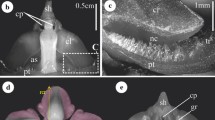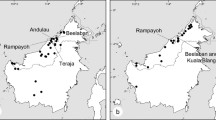Abstract
The reproductive structures ofDeplanchea tetraphylla (Bignoniaceae) exhibit a significant number of unusual features: inflorescence with an apical “platform”; flowers yellow, short-tubed, strongly zygomorphic; mouth closed through lateral compression; stamens and style long-exserted, erect or slightly reclined; nectar dark brown, exposed in the spoon-shaped lowermost corolla lobe and apparently acting also as a visual cue. These features suggest a highly elaborate syndrome for bird pollination: the birds (probably lorikeets) perch on the inflorescence platform and bend downwards to take up the exposed nectar, thus touching the exserted anthers and stigmas with the throat or breast. The likely evolution of this syndrome by additive steps, effecting a change from “head up” to “head down” position of the pollinator, can be traced from the floral structure of the remaining four species of the genus.
Similar content being viewed by others
References
Armstrong, J. A., 1979: Biotic pollination mechanisms in the Australian flora—a review. — New Zealand J. Bot.17, 467–508.
Burtt, B. L., Smith, R. M., 1986:Etlingera: the inclusive name forAchasma, Geanthus andNicolaia (Zingiberaceae). — Notes Roy. Bot. Gard. Edinburgh43, 235–241.
Collins, B. G., 1983: Pollination ofMimetes hirtus (Proteaceae) by Cape Sugarbirds and Orange-brested Sunbirds. — J. South African Bot.49, 125–142.
Curtis, W., 1797:Melianthus minor (=M. comosus). — Curtis Bot. Mag.3, tab. 301.
Ford, H. A., Paton, D. C., Forde, N., 1979: Birds as pollinators of Australian plants. — New Zealand J. Bot.17, 509–519.
Forshaw, J. M., 1973: Parrots of the World. — New York: Doubleday & Co.
Heine, H., 1976: Bignoniaceae. — InAubreville, A., Leroy, J.-F., (Eds.): Flore de la Nouvelle Calédonie et Dépendences 7. — Paris: Mus. Nat. d'Hist. Natur.
Knuth, P., 1905: Handbuch der Blütenbiologie3/2. — Leipzig: Engelmann.
Mostert, D. P., Siegfried, W. R., Louw, G. N., 1980:Protea nectar and satellite fauna in relation to the food requirement and pollination role of the Cape Sugarbird. — South African J. Sci.76, 409–412.
Müller-Doblies, D., 1977: Über den geometrischen Zusammenhang der monochasialen Verzweigungen am Beispiel einiger Liliifloren. — Ber. Deutsch. Bot. Ges.90, 351–362.
Lüttge, U., 1961: Über die Zusammensetzung des Nektars und den Mechanismus seiner Sekretion, I. — Planta56, 180–212.
Percival, M. S., 1961: Types of nectar in angiosperms. — New Phytol.60, 235–281.
Pijl, L., van der, 1957: The dispersal of plants by bats (Chiropterochory). — Acta Bot. Neerl.6, 291–315.
Skead, C. J., 1967: The sunbirds of Southern Africa. — Cape Town, Amsterdam: A. Balkema.
Smith, R. M., 1986: New combinations inEtlingera Giseke (Zingiberaceae). — Notes Roy. Bot. Gard. Edinburgh43, 243–254.
Tracey, J. G., 1982: The vegetation of the humid tropical region of North Queensland. — Melbourne: CSIRO.
Trapp, A., 1956: Zur Morphologie und Entwicklungsgeschichte der Staubblätter sympetaler Blüten. — Bot. Studien5, 1–93.
Troll, W., 1964: Die Infloreszenzen. Typologie und Stellung im Aufbau des Vegetationskörpers1. — Jena: G. Fischer.
Van Steenis, C. G. G. J., 1927: MalayanBignoniaceae, their taxonomy, origin and geographical distribution. — Rec. Trav. Bot. Néerl.24, 789–1049.
—, 1928: TheBignoniaceae of the Netherlands Indies. — Bull. Jard. Bot. Buitenzorg, Ser.III/10, 173–290.
—, 1930: A revision of the QueenslandBignoniaceae. — Proc. Roy. Soc. Queensland41, 39–58.
- 1977:Bignoniaceae. — Invan Steenis, C. G. G. J., (Ed.): Flora Malesiana, Ser. I,8, 114–186.
Vogel, S., 1954: Blütenbiologische Typen als Elemente der Sippen-Gliederung. — Jena: G. Fischer.
Wrigley, J. W., Fagg, M., 1983: Australian Native Plants. — Sydney, London: Collins.
Author information
Authors and Affiliations
Rights and permissions
About this article
Cite this article
Weber, A., Vogel, S. The pollination syndrome ofDeplanchea tetraphylla (Bignoniaceae). Pl Syst Evol 154, 237–250 (1986). https://doi.org/10.1007/BF00990126
Received:
Issue Date:
DOI: https://doi.org/10.1007/BF00990126




